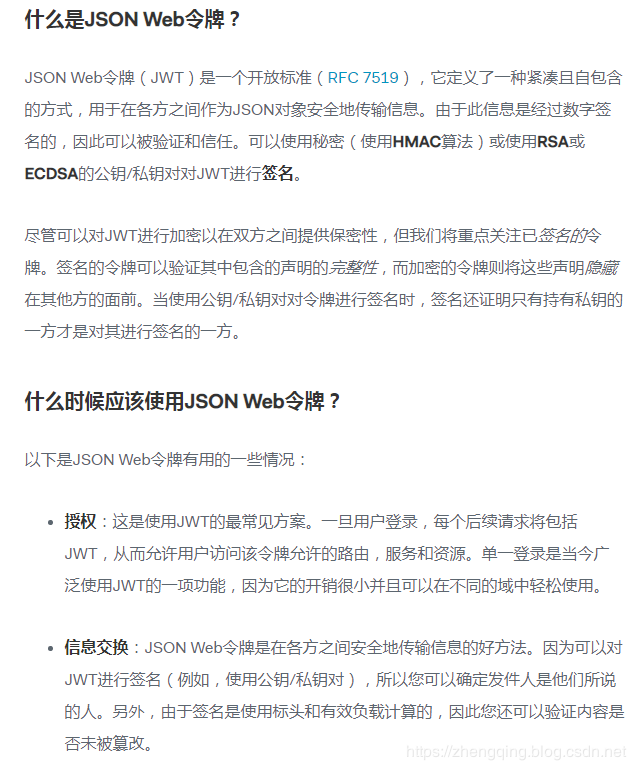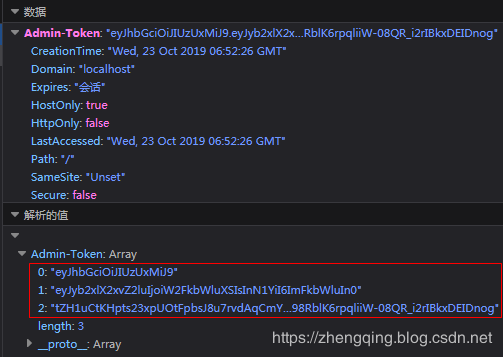Spring Security 整合JWT(四)
一、前言
本篇文章将讲述 Spring Security 简单整合JWT 处理认证授权
基本环境
- spring-boot 2.1.8
- mybatis-plus 2.2.0
- mysql 数据库
- maven项目
Spring Security入门学习可参考之前文章:
- SpringBoot集成Spring Security入门体验(一)
https://blog.csdn.net/qq_38225558/article/details/101754743 - Spring Security 自定义登录认证(二)
https://blog.csdn.net/qq_38225558/article/details/102542072 - Spring Security 动态url权限控制(三)
https://blog.csdn.net/qq_38225558/article/details/102637637
二、 Spring Security 简单整合 JWT
有关 JWT 不了解的可以看下官网文档: https://jwt.io/introduction/

1、引入jwt依赖
<!-- jwt依赖: https://mvnrepository.com/artifact/io.jsonwebtoken/jjwt -->
<dependency>
<groupId>io.jsonwebtoken</groupId>
<artifactId>jjwt</artifactId>
<version>0.9.1</version>
</dependency>
2、在Security登录认证成功后生成jwt令牌返回给前端保存
jwt生成令牌代码如下:
// 生成jwt访问令牌
String jwtToken = Jwts.builder()
// 用户角色
.claim("ROLE_LOGIN", "ADMIN")
// 主题 - 存用户名
.setSubject("张三")
// 过期时间 - 30分钟
.setExpiration(new Date(System.currentTimeMillis() + 30 * 60 * 1000))
// 加密算法和密钥
.signWith(SignatureAlgorithm.HS512, "helloworld")
.compact();
这里贴出小编文末案例demo源码中关于登录认证处理中的使用
@Component
public class AdminAuthenticationProvider implements AuthenticationProvider {
@Autowired
UserDetailsServiceImpl userDetailsService;
@Autowired
private UserMapper userMapper;
@Override
public Authentication authenticate(Authentication authentication) throws AuthenticationException {
// 获取前端表单中输入后返回的用户名、密码
String userName = (String) authentication.getPrincipal();
String password = (String) authentication.getCredentials();
SecurityUser userInfo = (SecurityUser) userDetailsService.loadUserByUsername(userName);
boolean isValid = PasswordUtils.isValidPassword(password, userInfo.getPassword(), userInfo.getCurrentUserInfo().getSalt());
// 验证密码
if (!isValid) {
throw new BadCredentialsException("密码错误!");
}
// 前后端分离情况下 处理逻辑...
// 更新登录令牌
// 当前用户所拥有角色代码
String roleCodes = userInfo.getRoleCodes();
// 生成jwt访问令牌
String jwt = Jwts.builder()
// 用户角色
.claim(Constants.ROLE_LOGIN, roleCodes)
// 主题 - 存用户名
.setSubject(authentication.getName())
// 过期时间 - 30分钟
.setExpiration(new Date(System.currentTimeMillis() + 30 * 60 * 1000))
// 加密算法和密钥
.signWith(SignatureAlgorithm.HS512, Constants.SALT)
.compact();
User user = userMapper.selectById(userInfo.getCurrentUserInfo().getId());
user.setToken(jwt);
userMapper.updateById(user);
userInfo.getCurrentUserInfo().setToken(jwt);
return new UsernamePasswordAuthenticationToken(userInfo, password, userInfo.getAuthorities());
}
@Override
public boolean supports(Class<?> aClass) {
return true;
}
}
前端页面保存的jwt令牌格式如下:

3、Security访问鉴权中认证用户信息
我们在访问每一个url请求的时候,在统一认证的地方获取jwt中我们需要的信息然后认证即可,【注: Claims 中存放着我们需要的信息】
例如: 我们可以将用户名、密码存放jwt中,然后在认证的时候读取到其中的用户信息,然后查询数据库认证用户,如果满足条件即成功访问,如果不满足条件即抛出异常处理
温馨小提示:如果jwt令牌过期,会抛出 ExpiredJwtException 异常,我们需要拦截到,然后交给认证失败处理器中处理,然后返回给前端,这里根据个人业务实际处理即可~
// 获取jwt中的信息
Claims claims = Jwts.parser().setSigningKey("helloworld").parseClaimsJws(jwtToken.replace("Bearer", "")).getBody();
// 获取当前登录用户名
System.out.println("获取当前登录用户名: " + claims.getSubject());
小编项目中认证过滤器中的使用如下:
@Slf4j
@Component
public class MyAuthenticationFilter extends OncePerRequestFilter {
@Autowired
AdminAuthenticationEntryPoint authenticationEntryPoint;
private final UserDetailsServiceImpl userDetailsService;
protected MyAuthenticationFilter(UserDetailsServiceImpl userDetailsService) {
this.userDetailsService = userDetailsService;
}
@Override
protected void doFilterInternal(HttpServletRequest request, HttpServletResponse response, FilterChain filterChain) throws ServletException, IOException {
MultiReadHttpServletRequest wrappedRequest = new MultiReadHttpServletRequest(request);
MultiReadHttpServletResponse wrappedResponse = new MultiReadHttpServletResponse(response);
StopWatch stopWatch = new StopWatch();
try {
stopWatch.start();
// 前后端分离情况下,前端登录后将token储存在cookie中,每次访问接口时通过token去拿用户权限
String jwtToken = wrappedRequest.getHeader(Constants.REQUEST_HEADER);
log.debug("后台检查令牌:{}", jwtToken);
if (StringUtils.isNotBlank(jwtToken)) {
// JWT相关start ===========================================
// 获取jwt中的信息
Claims claims = Jwts.parser().setSigningKey(Constants.SALT).parseClaimsJws(jwtToken.replace("Bearer", "")).getBody();
// 获取当前登录用户名
System.out.println("获取当前登录用户名: " + claims.getSubject());
// TODO 如需使用jwt特性在此做处理~
// JWT相关end ===========================================
// 检查token
SecurityUser securityUser = userDetailsService.getUserByToken(jwtToken);
if (securityUser == null || securityUser.getCurrentUserInfo() == null) {
throw new BadCredentialsException("TOKEN已过期,请重新登录!");
}
UsernamePasswordAuthenticationToken authentication = new UsernamePasswordAuthenticationToken(securityUser, null, securityUser.getAuthorities());
// 全局注入角色权限信息和登录用户基本信息
SecurityContextHolder.getContext().setAuthentication(authentication);
}
filterChain.doFilter(wrappedRequest, wrappedResponse);
} catch (ExpiredJwtException e) {
// jwt令牌过期
SecurityContextHolder.clearContext();
this.authenticationEntryPoint.commence(wrappedRequest, response, null);
} catch (AuthenticationException e) {
SecurityContextHolder.clearContext();
this.authenticationEntryPoint.commence(wrappedRequest, response, e);
} finally {
stopWatch.stop();
}
}
}
简单的入门使用就是这样了
三、总结
- 引入
jwt依赖 - 登录系统成功后
生成jwt令牌返回给前端保存到浏览器请求头中 - 在每一次请求访问系统url时,在统一认证过滤器中获取到请求头中jwt令牌中保存的
用户信息然后做认证处理,如果满足条件成功访问,如果不满足交给认证失败处理器返回指定内容给前端
本文案例demo源码
https://gitee.com/zhengqingya/java-workspace
正文到此结束
- 本文标签: Select src constant 权限控制 mysql maven tar 数据 parse build Service token authenticate UI HTML provider 处理器 bug 认证 js map App 总结 Security springboot 源码 https sql 时间 final 文章 Spring Security web git 密钥 mybatis ACE id update ip cat 代码 key Word IO java servlet 文案 SDN json http mapper 加密 spring mina 数据库 IDE
- 版权声明: 本文为互联网转载文章,出处已在文章中说明(部分除外)。如果侵权,请联系本站长删除,谢谢。
- 本文海报: 生成海报一 生成海报二
热门推荐
相关文章
Loading...











![[HBLOG]公众号](https://www.liuhaihua.cn/img/qrcode_gzh.jpg)

